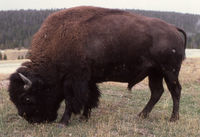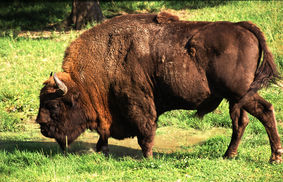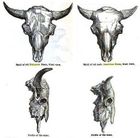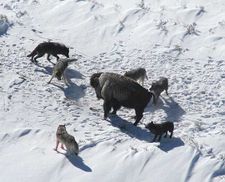Bison
| Bison | |
|---|---|
 |
|
| American Bison (Bison bison) | |
 |
|
| European bison/wisent (Bison bonasus) | |
| Scientific classification | |
| Kingdom: | Animalia |
| Phylum: | Chordata |
| Class: | Mammalia |
| Order: | Artiodactyla |
| Family: | Bovidae |
| Subfamily: | Bovinae |
| Genus: | Bison Hamilton Smith, 1827 |
| Species | |
|
†B. antiquus |
|
Members of the genus Bison are large even-toed ungulates within the subfamily Bovinae. Two extant species and four extinct species are recognized. The surviving species are the American bison, Bison bison (with two subspecies, the plains bison, Bison bison bison, and the wood bison, Bison bison athabascae), found in North America, and the European bison, or wisent (Bison bonasus), found in Europe and the Caucasus. While these species are usually grouped into their own genus, they are sometimes included in the closely related genus Bos,[1] together with cattle, gaur, kouprey and yaks, with which bison can interbreed.
Contents |
Description


The American bison and the European wisent are the largest terrestrial animals in North America and Europe. Bison are nomadic grazers and travel in herds, except for the non-dominant bulls, which travel alone or in small groups during most of the year. American bison are known for living in the Great Plains. Both species were hunted close to extinction during the 19th and 20th centuries but have since rebounded. The American Plains bison is no longer listed as endangered, but the Wood Bison is on the endangered species list in Canada.[2]
Although superficially similar, there are a number of physical and behavioural differences between the American and European bison. The American species has 15 ribs, while the European bison has 14. The American bison has four lumbar vertebrae, while the European has five.[3] Adult American bison are not as rangy in build, and have shorter legs.[4] American bison tend to graze more, and browse less than their European cousins. Their anatomies reflect this behavioural difference; the American bison's head hangs closer to the earth than the European's. The body of the American bison is typically hairier, though its tail has less hair than that of the European bison. The horns of the European bison point through the plane of their faces, making them more adept at fighting through the interlocking of horns in the same manner as domestic cattle, unlike the American bison which favours butting.[5] American bison are more easily tamed than their European cousins, and breed with domestic cattle more readily.[6]
Behavior

Wallowing is a common behavior of bison. A bison wallow is a shallow depression in the soil, either wet or dry. Bison roll in these depressions, covering themselves with mud or dust. Possible explanations suggested for wallowing behavior include grooming behavior associated with moulting, male-male interaction (typically rutting behavior), social behavior for group cohesion, play behavior, relief from skin irritation due to biting insects, reduction of ectoparasite load (ticks and lice), and thermoregulation.[7] In the process of wallowing bison may become infected by the fatal disease anthrax, which may occur naturally in the soil.[8]
The bison's temperament is often unpredictable. They usually appear peaceful, unconcerned, even lazy, yet they may attack anything, often without warning or apparent reason. They can move at speeds of up to thirty-five miles per hour and cover long distances at a lumbering gallop.[9]
Their most obvious weapon is the horns that both male and female have. But their head, with its massive skull, can be used as a battering ram, effectively using the momentum produced by two thousand pounds moving at thirty miles per hour. The hind legs can also be used to kill or maim with devastating effect. At the time bison ran wild, they were rated second only to the Alaska brown bear as a potential killer, more dangerous than the grizzly bear. In the words of early naturalists, they were a dangerous, savage animal that feared no other animal and in prime condition could best any foe.[9]
The rutting, or mating, season lasts from June through September with peak activity in July and August. At this time, the older bulls rejoin the herd and fights often take place between bulls. The herd exhibits much restlessness during breeding season. The animals are belligerent, unpredictable and most dangerous.[9]
Diet
Bison have a fairly simple diet. The bison's main food is grass. Bison also eat the low lying shrubbery that is available. In the winter, bison forage in the snow looking for grass. If there is little grass available, bison have to resort to eating the twigs of shrubs.
Predators
Due to their large size few predators attack bison. Wolf packs can take down a bison. There are even documented cases of a single wolf taking down bison (Schmidt & Mech, 1997). Brown bears will also prey on calves, and have been observed driving off wolves to take over their kills.
Gallery
|
Legendary albino buffalo statue at the Scurry County courthouse in Snyder, Texas |
Herd of bison grazing in Elk Island National Park, Alberta, Canada |
 Bison feeding - Alberta |
 Bison in winter, Alberta |
 Bison antiquus skeleton |
 An American Bison standing its ground against a gray wolf pack. |
A small group of bison at Antelope Island State Park surrounded by the Great Salt Lake in Utah. |
 Bison cow and calf |
See also
- Gaur
- Wood Bison
- African Buffalo
- Great bison belt
- Wisent
References
- ↑ Groves, C. P., 1981. Systematic relationships in the Bovini (Artiodactyla, Bovidae). Zeitschrift für Zoologische Systematik und Evolutionsforschung, 4:264-278., quoted in Don E. Wilson & DeeAnn M. Reeder (editors). 2005. Mammal Species of the World. A Taxonomic and Geographic Reference (3rd ed), Johns Hopkins University Press: "Bison". (online edition)
- ↑ "U.S. Fish and Wildlife Service Species Report". http://ecos.fws.gov/tess_public/SpeciesReport.do?groups=A&listingType=L&mapstatus=1. Retrieved 2009-06-03.
- ↑ The Penny Cyclopædia of the Society for the Diffusion of Useful Knowledge by Society for the Diffusion of Useful Knowledge (Great Britain), published by C. Knight, 1835
- ↑ Trophy Bowhunting: Plan the Hunt of a Lifetime and Bag One for the Record Books, by Rick Sapp, Edition: illustrated, published by Stackpole Books, 2006, ISBN 0811733157, 9780811733151
- ↑ American Bison: A Natural History, By Dale F. Lott, Harry W. Greene, ebrary, Inc, Contributor Harry W. Greene, Edition: illustrated, Published by University of California Press, 2003 ISBN 0520240626, 9780520240629
- ↑ Zoologist: A Monthly Journal of Natural History, By Edward Newman, James Edmund Harting, Published by J. Van Voorst, 1859
- ↑ "Wallowing Behavior of American Bison (Bos Bison)". JSTOR. April 10, 2008. http://www.jstor.org/pss/3083019.
- ↑ "Anthrax kills bison in southern N.W.T.". CBC.CA. July 8, 2006. http://www.cbc.ca/canada/north/story/2006/07/06/anthrax-nwt-bison.html.
- ↑ 9.0 9.1 9.2 "American Bison". http://www.nps.gov/archive/wica/Bison.htm.
External links
|
||||||||||||||||||||||||||||||||||||||||||||||||||||||||||||||||||||||||||||||||||||||||||||||||||||||||||||||||||||||||||||||||||||||||||||||||||||||||||||||||||||||||||||||||||||||||||||||||||||||||||||||||||||||||||||||||||||||||||||||||||||||||||||||||||||||||||||||||||||||||||||||||||||||||||||||||||||||||||||||||||||||||||||||||||||||||||||||||||||||||||||||||||||||||||||||||||||